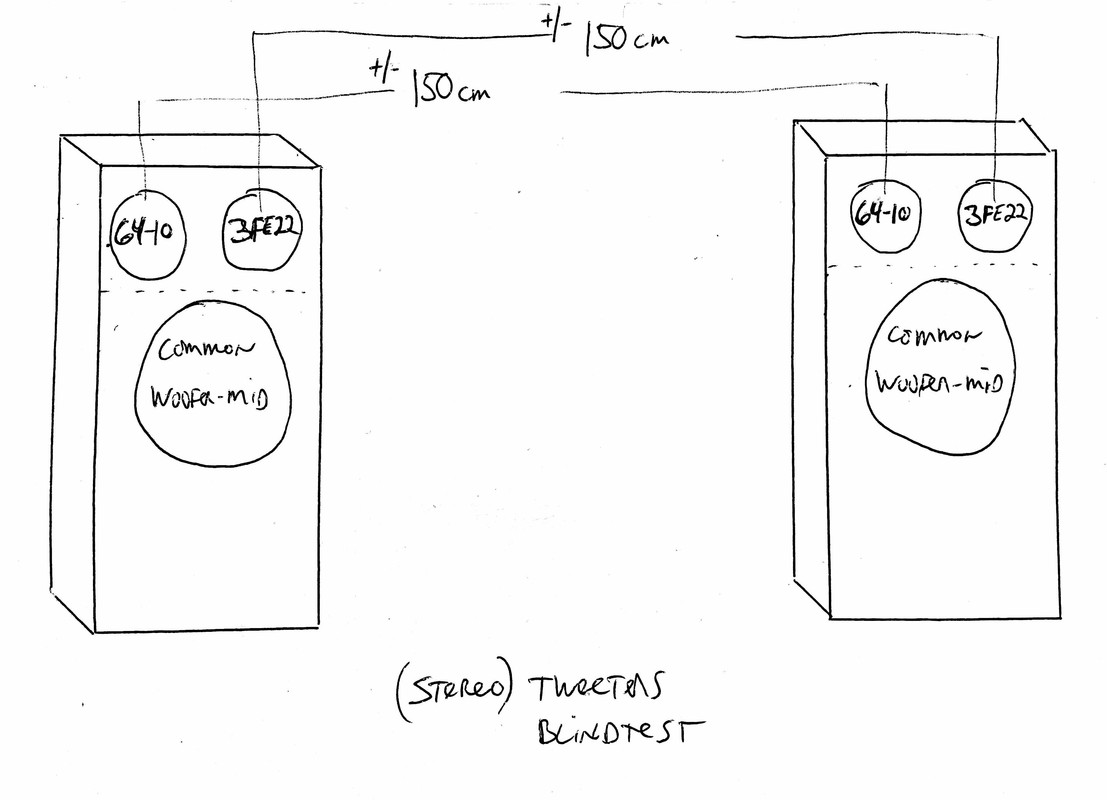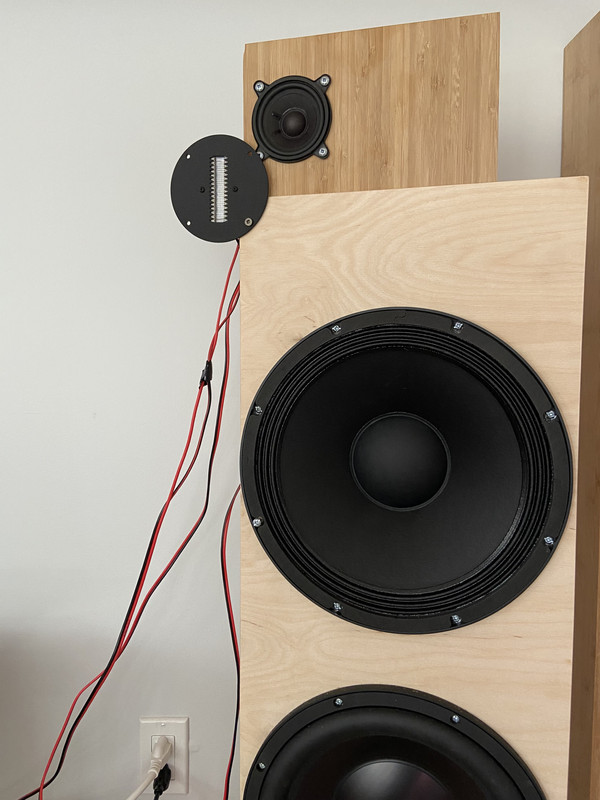Tweeters blindtest

Would that make sense?
1) ABX identification blindtest for the tweeters
2) RAAL 64-10 v.s. FaitalPro 3fe22
3) common woofer mid (to determine)
4) In stereo
5) At the maximum distance from each pairs and to the listener so it's not spotted by the different spatial positionning
6) SPL-matched and EQ'd for a flat response
7) highpass 48db/octave butterworth @ 3khz (min. for 64-10)

Would that make sense?
1) ABX identification blindtest for the tweeters
2) RAAL 64-10 v.s. FaitalPro 3fe22
3) common woofer mid (to determine)
4) In stereo
5) At the maximum distance from each pairs and to the listener so it's not spotted by the different spatial positionning
6) SPL-matched and EQ'd for a flat response
7) highpass 48db/octave butterworth @ 3khz (min. for 64-10)
Also, if the woofer-mid is solid enough, we could try a high-spl run (100-105db) which would probably be the maximum from the 3fe22...
So Mr. Tchaikovsky will be happy.
So Mr. Tchaikovsky will be happy.
My suggestion:
Rotary box on top of the midbass.
Face A: Dome
Face B: Ribbon
Face C: AMT
Face D: Compression
First level: No EQ and optimum Xover point for each DUT.
If detection is positive we move to the next level.
Level2: EQ, level match and optimum Xover point for each DUT.
Rotary box on top of the midbass.
Face A: Dome
Face B: Ribbon
Face C: AMT
Face D: Compression
First level: No EQ and optimum Xover point for each DUT.
If detection is positive we move to the next level.
Level2: EQ, level match and optimum Xover point for each DUT.
I have had various drivers compared from 1.5khz up on the same cardboard box. Mid and woofer in separate box. Compression driver mounted directly behind the baffle. Tests done outdoors and in a large garage. 1" foam on baffle. High spl peak was around 125db @ 1 meter.
1. 3FE22
2. DE250
3. Peerless 2544
4. Faital HF146R
5. Bliesma T34A
6. Radian Neo 745
At low spl they all sounded good except for the Faital 146 which didn't sound as extended up high no matter what eq I tried.
At high spl the 3FE22 became thermally compressed first. Never sounded bad.
The compression drivers get loud but they do sound progressively harsher at high levels. The bigger drivers do better.
The Bliesma was very clean until it I blew it. The Radian was not quite as smooth but goes very loud. The Radian was my overall favorite for high spl non-horn loaded tweeter from this group.
Best dispersion goes to the Bliesma and 1" compression drivers. Still need to put the Dayton PS65LP against the Radian at high power.
1. 3FE22
2. DE250
3. Peerless 2544
4. Faital HF146R
5. Bliesma T34A
6. Radian Neo 745
At low spl they all sounded good except for the Faital 146 which didn't sound as extended up high no matter what eq I tried.
At high spl the 3FE22 became thermally compressed first. Never sounded bad.
The compression drivers get loud but they do sound progressively harsher at high levels. The bigger drivers do better.
The Bliesma was very clean until it I blew it. The Radian was not quite as smooth but goes very loud. The Radian was my overall favorite for high spl non-horn loaded tweeter from this group.
Best dispersion goes to the Bliesma and 1" compression drivers. Still need to put the Dayton PS65LP against the Radian at high power.
Last edited:
My suggestion:
Rotary box on top of the midbass.
Face A: Dome
Face B: Ribbon
Face C: AMT
Face D: Compression
First level: No EQ and optimum Xover point for each DUT.
If detection is positive we move to the next level.
Level2: EQ, level match and optimum Xover point for each DUT.
Before spending to much time and energy on that, since you're suggestion is only mono, I would make a very basic pre-test first...

I see no reason to have a list of 4 drivers, while we should start with two.
Would be easy to do by switching configurations on the miniDSP, as I need 3 channels. Could even add the 4th channel but it won't be from the same amplifier...

Even have a compression on hand to test... 😉
So basically a cone v.s. a ribbon v.s. a compression.
Woult it be a good start, sir?
Your setup is not valid IMO as the tweeters can't have different positions relative to the baffle. The FR will be all over the place.
Your setup is not valid IMO as the tweeters can't have different positions relative to the baffle. The FR will be all over the place.
you want to reach a threshold or not?
First level: No EQ and optimum Xover point for each DUT.
If detection is positive we move to the next level.
I would like to see the results of the original test if it were conducted in an average listening room (I'm talking about the sort of room people with no awareness of room treatments and such would have) With speaker placed in a typical spot that one of a stereo pair would be, with a distance to listener of around 3M.
Perhaps it wouldn't change anything, but I suspect it would.
Further (and this would be a LOT more work). it would be very interesting to see the results of the same setup above, but with a two way setup. Use the same tweeter for all of the tests, matched with different midranges. equed however you like, and then see whether people can spot the difference.
IMO the original test in and of itself cannot lead one to the conclusion that when used in a real world scenario, especially once you need to start to integrate with another driver, that simply equing the drivers will result in no difference being detectable.
Tony.
Perhaps it wouldn't change anything, but I suspect it would.
Further (and this would be a LOT more work). it would be very interesting to see the results of the same setup above, but with a two way setup. Use the same tweeter for all of the tests, matched with different midranges. equed however you like, and then see whether people can spot the difference.
IMO the original test in and of itself cannot lead one to the conclusion that when used in a real world scenario, especially once you need to start to integrate with another driver, that simply equing the drivers will result in no difference being detectable.
Tony.
Last edited:
And if you are correct, as I think you are, then the suggestion from the test that all midrange range drivers are pretty much the same and therefore there is no reason to spend more than about $20 on one of them is not only useless, but unfortunately very misleading.
And if you are correct, as I think you are, then the suggestion from the test that all midrange range drivers are pretty much the same and therefore there is no reason to spend more than about $20 on one of them is not only useless, but unfortunately very misleading.

Cute. I guess that's the best you can do when don't have a valid response.
What do you expect? Repeat the test yourself if you have the guts. No, I didn't think so. I bet, within spl reason, that it will not matter if you have a tweeter or not - if the same FR is maintained for both the midrange and tweeter region.
You only "think" it would matter... please explain why.
//
you want to reach a threshold or not?
Utilizing the same baffle position placement would prevent a test from establishing a threshold how?
Interesting thread title. It led me to check who authored the thread on dacs sounding the same, as both claims seem like the work of the same person. Sure enough, the same person.
I can't wait for your turntable review.
I can't wait for your turntable review.
What do you expect? Repeat the test yourself if you have the guts. No, I didn't think so. I bet, within spl reason, that it will not matter if you have a tweeter or not - if the same FR is maintained for both the midrange and tweeter region.
You only "think" it would matter... please explain why.
//
Once again it is going to depend on the room and listening distance. Directivity mis-matches between the tweeter and the mid driver are much more likely with some combinations than with others. If the room is not in the equation it won't matter, but any nastiness off axis will start to show up if the test is run in a way that that allows that to show through.
Tony.
That seems obvious to some and totally incomprehensible to others, why? Measurements could have confirmed the results, what is the point of discussion without measurements? It's as meanlingless and pointless as Markw4 saying "sounds much better" at every available opportunity.IMO the original test in and of itself cannot lead one to the conclusion that when used in a real world scenario, especially once you need to start to integrate with another driver, that simply equing the drivers will result in no difference being detectable.
IMO the original test in and of itself cannot lead one to the conclusion that when used in a real world scenario, especially once you need to start to integrate with another driver, that simply equing the drivers will result in no difference being detectable.
Tony.
This. By chance I came across another recent post by the OP that would seem to agree with your conclusions
https://www.diyaudio.com/forums/full-range/353270-opinion-faitalpro-3fe22-4fe32.html#post6173789
"Out-of-the-box, the 3fe22 sounds good. But once EQ'd... not sure which is better (free air). So I guess it's all about the in-box performances?"
At this point I think he's trolling. Dunno.
I am for once very glad that we can stop using those expensive midrange drivers with pefectly flat fr response, low distortion, benign, alost nonexistent cone breakups, clean waterfall with no ringing, perfect impulse response, ruler flat phase...did i miss anything...and now we can get two dollar taiwanese midrange driver made of plastic with magnet size of peanut.
Good grief!
Good grief!
- Status
- Not open for further replies.
- Home
- Loudspeakers
- Multi-Way
- BLINDTEST: Midrange 360-7200hz, NO audible difference whatsover.